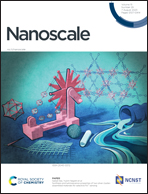Gram-scale solvothermal synthesis of Fe-doped CuCoO2 nanosheets and improvement of the oxygen evolution reaction performance†
Abstract
In this work, we used Cu-BTC-IPA and Co(NO3)2·6H2O as precursors to synthesize CuCoO2 (CCO) nanocrystals with a suitable crystal phase, morphology and high yield by changing the process parameters, such as reactant concentration, reactant ratio, mineralizer dosage, and the type of polyvinylpyrrolidone surfactant. In addition, the effects of different concentrations (1 at%, 3 at%, 5 at%) of Fe doping on the crystal structure and oxygen evolution reaction (OER) performance of CCO were studied. The experimental results show that Fe ions are uniformly doped into the lattice to replace the A-site (Cu+) position, which not only reduces the grain size of CCO, but also increases its specific surface area. We further employed the density functional theory (DFT) method to simulate the OER process of transition metal Fe-doped CCO (A-site substitution) and proposed that Fe doping can reduce the Gibbs free energy of each step and promote the formation of each intermediate, thereby improving its OER catalytic performance. In 1.0 M KOH electrolyte, the 3 at% Fe-doped CCO (Ni@3FCCO) electrode has the best OER performance (η10 = 369 mV, Tafel slope = 69 mV dec−1), and the required overpotential to attain 10 mA cm−2 slightly increased (∼30.2 mV) after 18 hours of continuous OER. The crystal morphology and chemical composition did not change significantly before and after the long-term OER test, indicating that the 3FCCO nanosheets have good OER activity and stability. We have proposed two reasons for the significant improvement of OER performance for Fe-doped CCO nanosheets: (1) the partial substitution of Cu cations by Fe cations not only regulates the electronic structure of CCO, making the catalytically active center no longer a single Co site, but also contains the Fe site, thus increasing the number of overall active sites; (2) the synergistic effect between Fe cations and Co cations in the OER process could enhance the activity of a single active site.



 Please wait while we load your content...
Please wait while we load your content...